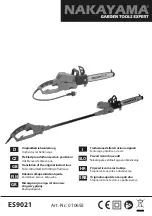
Section 22: Raising the Saw Head to Vertical Position
22.1 Loosen the LOCKING BOLT (ITEM 35).
22.2 EXTEND THE VERTICAL SUPPORT LEG (Item 36)
about 6”.
22.3 Re-lock the locking bolt.
22.4 Lift the saw head so that it is perpendicular to the saw bed.
(Item 54).
22.5 With the saw head held upright, readust the position of the
VERTICAL SUPPORT LEG to touch the floor.
22.6 Re-lock the LOCKING BOLT.
22.7 Place the VERTICAL TABLE (Item 9) in place with about
1 ‘ clearance between it and the lower BEARING GUIDE
assembly. (Item 18).
Section 23: Vertical Operation
Although this machine will be used primarily as a cutoff saw,
— Notching, Slitting, and Contour Work will be done at times
with the saw head in the vertical position.
A VERTICAL TABLE (Item 9) is included with this bandsaw,
for this purpose.
For vertical operation, be sure that a fine-tooth saw blade is
installed in the saw, since in vertical operation the material to
be cut will most likely be of a light gauge.
23.1 Raise the saw head to its vertical position, (Section 21)
23.2 Install the VERTICAL TABLE.
23.3 Set the top BLADE GUIDE (Item 18) to a height above
the VERTICAL TABLE equal to 1/8” more than the thickness
of the stock material.
23.4 Proceed with cutting.
The same speed principles apply to vertical cutting as apply in
the case of horizontal cutting.
Feeding the material to be cut into the saw blade is obviously a
hand operation in vertical cutting, so
EXERCISE CAUTION AT ALL TIMES.
With practice, you will readily beome aware of the amount of
pressure that will be needed to achieve the best cutting
efficiency, (See Section 6).
Section 24: Switch Actuator Adjustment
Adjust the SWITCH ACTUATOR (Item 44) up or down so that
the ON-OFF SWITCH (Item 45) is turned “OFF” when the saw
has cut through the workpiece.
Section 25: Programming
To avoid costly, time consuming changeovers and re-
adjustments, it is wise to plan in advance the cuts
to be made, and do them all in the same set up.
Section 26: Important Notes
The BLADE GUIDE BEARING adjustments outlined in
Sections 12 and 13 are the most impor tant adjustments on
your saw. It is impossible to get satisfactory work from
your saw if the BLADE GUIDES are not properly
adjusted.
The BLADE GUIDES are adjusted and power tested with
several test cuts before leaving the factory to ensure
proper setting and the need for readjusting should rarely
occur when the saw is properly used.
However, if the BLADE GUIDES do get out of
adjustment, it is extremely important to re-adjust them at
once.
If improper adjustment is allowed, the blades will not cut
straight, and if the situation is not corrected, it will cause
serious blade damage.
Because BLADE GUIDE adjustment is a critical factor in
the performance of your saw, it is always best to try a new
blade to see of this will first correct poor cutting before
proceeding with any readjust ing.
If a blade becomes dull on one side sooner than on the
other, forexample, itwill begin cutting crooked.
A simple blade change will correct this problem whereas
the more difficult BLADE GUIDE adjust ment will not.
If a new blade does not correct the problem, check the
BLADE GUIDES for proper spacing.
For most efficient operation and maximum accu racy in
cutting, the BLADE GUIDE BEARINGS should just
touch the blade so that they will still turn freely.
Care should be taken to ensure that the welded blade area
is no thicker than the parent metal.
A minimum of three (3) teeth should be on the workpiece
at all times, for proper cutting, — if the teeth of the blade
are so far apart that they straddle the workpiece, severe
damage to the workpiece and to the blade can result.
CARE MUST BE EXERCISED TO KEEP THE
BLADE FROM RUBBING EXCESSIVELY ON THE
SHOULDER OF THE BLADE WHEELS AS THIS
WILL DAMAGE THE PULLEYS AND/OR BLADE.
5




























